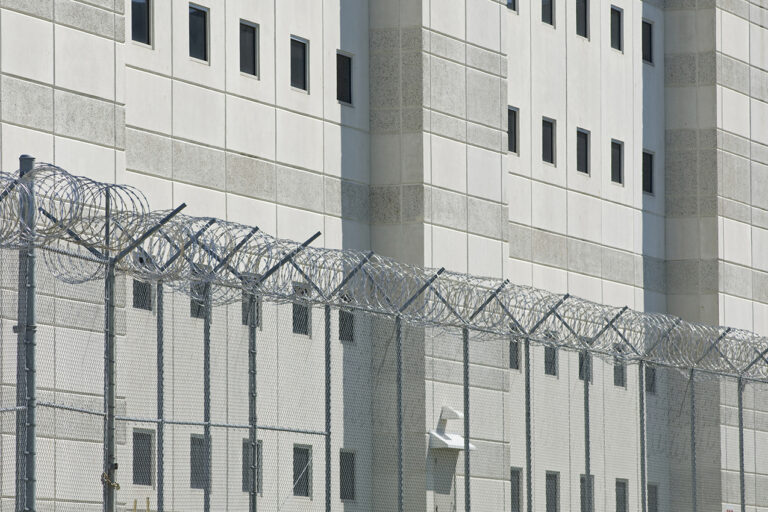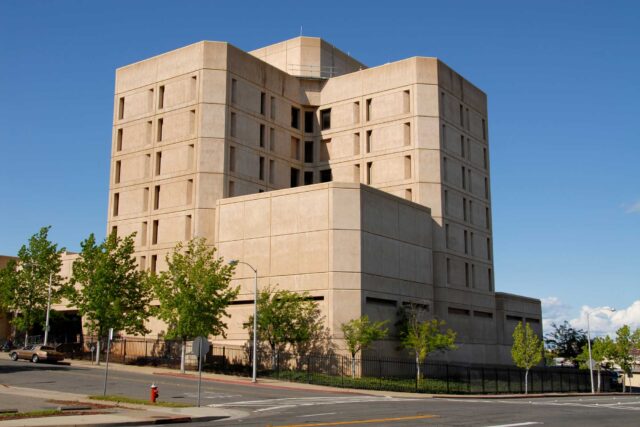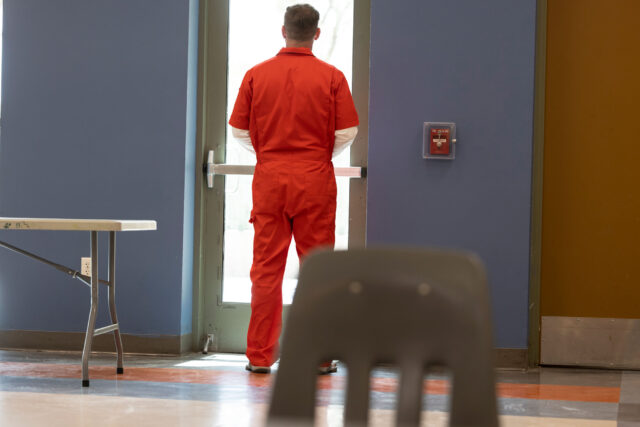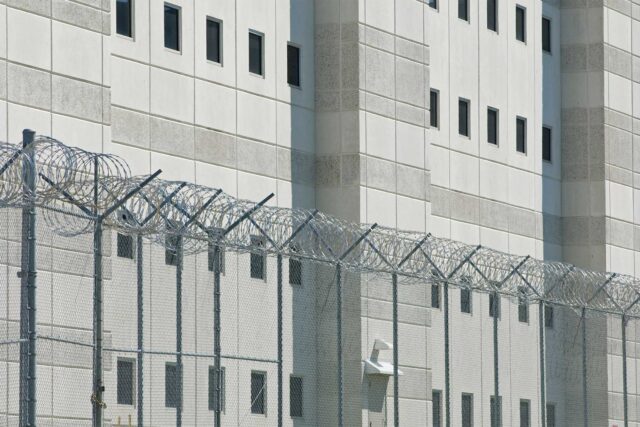The jail population is significantly lower than it was before the pandemic.
- Criminal justice responses to the pandemic contributed to a dramatic plunge in the jail population. After remaining between 70,000 and 75,000 since January 2015, the jail population dropped by roughly 22,000 inmates between February 2020 and May 2020, to just under 50,000.
- The jail population climbed from May 2020 until early 2023, when it began to fall again. As of June 2023, the population stood at roughly 54,500—well below pre-pandemic levels.
- The jail population increased during the first few years of Public Safety Realignment (implemented in 2011), but both Proposition 47 (which reclassified several property and drug felonies as misdemeanors in 2014) and pandemic policies reduced the population to 66% of what it was 10 years ago.
County jail populations dropped sharply after Proposition 47 passed and plunged at the beginning of the pandemic
Number of jail inmates
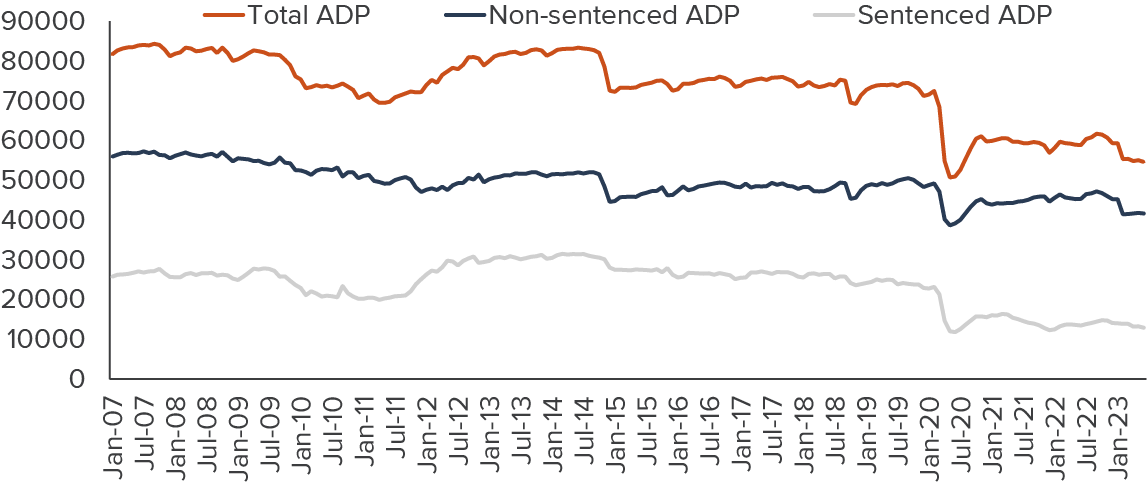
SOURCE: Jail Profile Survey, January 2007–June 2023, Board of State and Community Corrections.
NOTE: ADP = Average daily population.
The jail environment has shifted significantly in recent years.
- Bookings into jail dropped sharply in the first few months of the pandemic, from roughly 70,000 in February 2020 to only 31,000 in May 2020. In the first half of 2023, bookings ranged from 45,000 to 55,000.
- In addition, both Prop 47 and pandemic-era drops in the jail population reduced the need to manage capacity through early releases. In the first few months of 2023, the state averaged 3,300 early releases, compared to over 8,000 in the months before Prop 47 was passed.
- The share of inmates with mental health needs has grown over the past decade. It rose from around 11,000 (roughly 20% of the jail population) in 2010 to 25,000 (37%) in 2019; as of June 2023 (the most recent month of jail population data), the number was around 19,000, which is more than 50% of the jail population among agencies that reported mental health case data.
Capacity-constrained releases have fallen since the passage of Proposition 47 in 2014
Total capacity-constrained releases
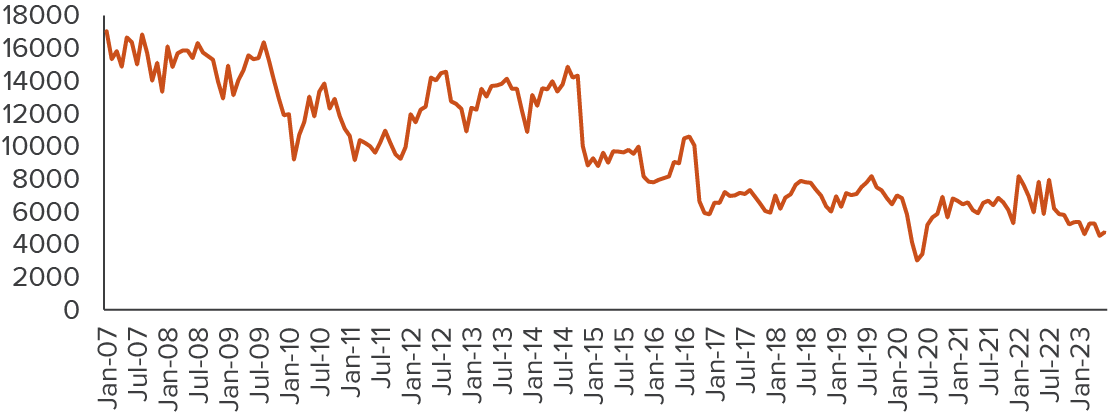
SOURCE: Jail Profile Survey, January 2007–June 2023, Board of State and Community Corrections.
NOTE: Release figures include both non-sentenced and sentenced inmates.
The jail population is largely male and being held for felonies.
- As of June 2023, men make up the vast majority (89%) of the jail population.
- More than 76% of all inmates are awaiting either arraignment, trial, or sentencing (“non-sentenced”).
- Inmates held for felony charges or convictions account for 90% of the jail population.
- Historically, non-sentenced felony inmates have made up between 55% and 62% of the total jail population. The number of these inmates has dropped in recent years, but this group now accounts for about 70% of a smaller overall population.
California has a large number of diverse and aging county jail facilities.
- California counties operate several types of jails, including court holding facilities, temporary holding facilities, and long-term facilities.
- Nearly all counties have at least one long-term facility; there are more than 125 such facilities statewide, with over 83,000 beds (up from 76,000 in 2011).
- While many counties are operating facilities that are decades old, the state has made funding available to renovate and construct facilities.
Many new jail projects have been completed; long-term planning should factor in recent jail population changes.
- As of October 2023, $2.15 billion has been allocated for 54 jail projects across the state; 28 have been completed. These projects are adding over 12,500 new beds; the net gain will be nearly 8,500, as some of these beds will replace those in aging facilities.
- In addition to new or replacement jail beds, counties are gaining much-needed space for medical, educational, and other services that can help prepare inmates for successful reentry into the community.
- The drop in inmate populations under Prop 47 and during the pandemic should inform long-term construction plans. It is possible that fewer facilities will be needed—in May 2023, only nine were over capacity. The cost and length of time required to build new facilities make it important to consider needs carefully.
Topics
Criminal Justice

